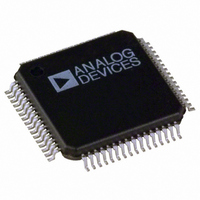ADE7166ASTZF8 Analog Devices Inc, ADE7166ASTZF8 Datasheet - Page 67

ADE7166ASTZF8
Manufacturer Part Number
ADE7166ASTZF8
Description
IC ENERGY METER 1PHASE 64LQFP
Manufacturer
Analog Devices Inc
Specifications of ADE7166ASTZF8
Applications
Energy Measurement
Core Processor
8052
Program Memory Type
FLASH (8 kB)
Controller Series
ADE71xx
Ram Size
512 x 8
Interface
I²C, SPI, UART
Number Of I /o
20
Voltage - Supply
3.135 V ~ 3.465 V
Operating Temperature
-40°C ~ 85°C
Mounting Type
Surface Mount
Package / Case
64-LQFP
Ic Function
Single Phase Energy Measurement IC
Supply Voltage Range
3.13V To 3.46V, 2.4V To 3.7V
Operating Temperature Range
-40°C To +85°C
Digital Ic Case Style
LQFP
No. Of Pins
64
Lead Free Status / RoHS Status
Lead free / RoHS Compliant
Available stocks
Company
Part Number
Manufacturer
Quantity
Price
Company:
Part Number:
ADE7166ASTZF8
Manufacturer:
Analog Devices Inc
Quantity:
10 000
Company:
Part Number:
ADE7166ASTZF8-RL
Manufacturer:
Analog Devices Inc
Quantity:
10 000
When a new half-line cycle is written in the LINCYC register
(Address 0x12), the LWATTHR register (Address 0x03) is reset,
and a new accumulation starts at the next zero crossing. The
number of half-line cycles is then counted until LINCYC is
reached. This implementation provides a valid measurement at
the first CYCEND interrupt after writing to the LINCYC
register (see Figure 71). The line active energy accumulation
uses the same signal path as the active energy accumulation.
The LSB size of these two registers is equivalent.
Using the information from Equation 10 and Equation 11,
where:
n is an integer.
T is the line cycle period.
Because the sinusoidal component is integrated over an integer
number of line cycles, its value is always 0. Therefore,
Note that in this mode, the 16-bit LINCYC register can hold a
maximum value of 65,535. In other words, the line energy
accumulation mode can be used to accumulate active energy for
a maximum duration of over 65,535 half-line cycles. At a 60 Hz
line frequency, it translates to a total duration of 65,535/120 Hz
= 546 sec.
REACTIVE POWER CALCULATION
(ADE7169/ADE7569)
Reactive power, a function available for the ADE7169/ADE7569
only, is defined as the product of the voltage and current wave-
forms when one of these signals is phase-shifted by 90°. The
resulting waveform is called the instantaneous reactive power
signal. Equation 23 gives an expression for the instantaneous
reactive power signal in an ac system when the phase of the
current channel is shifted by 90°.
LWATTHR REGISTER
E(t) = VInT
E
E
( )
=
t
CYCEND IRQ
Figure 71. Energy Accumulation When LINCYC Changes
nT
∫
0
=
VIdt
nT
∫
0
LINCYC
VALUE
VI
dt
+
0
−
⎧
⎪
⎪
⎨
⎪
⎪
⎩
1
+
VI
⎛
⎜
⎝
8
f
9 .
⎞
⎟
⎠
2
⎫
⎪
⎪
⎬
⎪
⎪
⎭
nT
∫
0
cos
(
2
π
ft
)
ADE7116/ADE7156/ADE7166/ADE7169/ADE7566/ADE7569
dt
(18)
(19)
(20)
Rev. B | Page 67 of 152
where:
θ is the phase difference between the voltage and current channel.
v is the rms voltage.
i is the rms current.
The average reactive power over an integral number of lines (n)
is given in Equation 24.
where:
T is the line cycle period.
q is referred to as the reactive power.
Note that the reactive power is equal to the dc component of
the instantaneous reactive power signal q(t) in Equation 23.
The instantaneous reactive power signal q(t) is generated by
multiplying the voltage and current channels. In this case, the
phase of the current channel is shifted by 90°. The dc component of
the instantaneous reactive power signal is then extracted by a
low-pass filter to obtain the reactive power information (see
Figure 72).
In addition, the phase-shifting filter has a nonunity magnitude
response. Because the phase-shifted filter has a large attenuation
at high frequency, the reactive power is primarily for calculation
at line frequency. The effect of harmonics is largely ignored in
the reactive power calculation. Note that, because of the mag-
nitude characteristic of the phase shifting filter, the weight of
the reactive power is slightly different from the active power
calculation (see the Energy Register Scaling section).
The frequency response of the LPF in the reactive signal path is
identical to the one used for LPF2 in the average active power
calculation. Because LPF2 does not have an ideal brick wall
frequency response (see Figure 65), the reactive power signal has
some ripple due to the instantaneous reactive power signal. This
ripple is sinusoidal and has a frequency equal to twice the line
frequency. Because the ripple is sinusoidal in nature, it is removed
when the reactive power signal is integrated to calculate energy.
The reactive power signal can be read from the waveform register
by setting the WAVMODE register (Address 0x0D) and the
WFSM bit (Bit 5) in the Interrupt Enable 3 SFR (MIRQENH,
Address 0xDB). Like the current and voltage channels waveform
sampling modes, the waveform data is available at sample rates of
25.6 kSPS, 12.8 kSPS, 6.4 kSPS, and 3.2 kSPS.
q(t) = v(t) × i’(t)
q(t) = VI sin (θ) + VI sin
v
t i
i
Q
) (
′
) (
) (
t
t
=
=
=
=
nT
1
2
2
2
nT
∫
0
I
V
I
q
sin(
) (
sin
sin(
t
dt
⎛
⎜
⎝
ω
ω
ω
t
=
)
t
t
VI
+
+
θ
π
2
sin(
)
⎞
⎟
⎠
2 (
θ
ωt
)
+
θ
)
(21)
(22)
(23)
(24)













